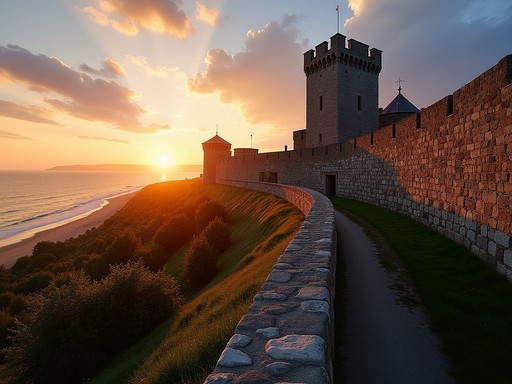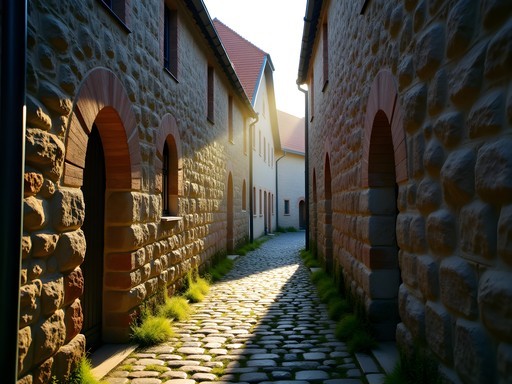Disclosure: This article contains affiliate links. We may earn a commission from purchases at no extra cost to you, which helps our travel content.
The morning sun casts long shadows across weathered limestone as I trace my fingers along Visby's ancient city wall. Standing here on Sweden's Gotland island feels like stepping through a portal in time—one where 13th-century Hanseatic merchants might appear around any corner. As someone who's spent decades documenting how cultures express themselves through physical spaces, I find Visby's remarkably preserved medieval cityscape nothing short of extraordinary. The 3.4-kilometer ring wall with its 27 remaining towers tells stories of prosperity, conflict, and resilience that span nearly a millennium. During my weekend exploration of this UNESCO World Heritage site, I discovered that Visby offers more than just impressive ruins—it presents an intimate connection with a European medieval trading center that once rivaled the greatest cities of its age. Whether you're drawn to historical architecture, cultural preservation, or simply the romance of walking hand-in-hand through cobblestone streets steeped in history, Visby rewards visitors with experiences that linger long after departure.
The Remarkable Ring Wall: Visby's Medieval Masterpiece
If cricket has its Lord's and rugby its Eden Park, then medieval defensive architecture has Visby's magnificent ring wall—perhaps the finest and most complete example in all of Northern Europe. Built primarily during the 13th and 14th centuries, this limestone marvel encircles the old town in a 3.4-kilometer embrace that has withstood both the ravages of time and the evolution of warfare.
What struck me immediately was the wall's sheer presence—in some sections reaching heights of 11 meters and thicknesses of 3 meters. Unlike many European walled cities where urban development has fragmented such structures, Visby's fortification remains approximately 90% intact. Walking its perimeter offers a lesson in medieval engineering that even my engineering-minded teenage son would appreciate.
I began my exploration at Norderport (North Gate), where the morning light creates the most dramatic shadows across the ancient stonework. From here, I followed the wall clockwise, discovering that each section reveals unique architectural elements and repair techniques spanning several centuries. The 27 remaining towers (of an original 29 or more) each tell their own story—some squat and functional, others soaring with gothic influences.
At the Maiden's Tower (Jungfrutornet), I paused to consider the tragic legend of the maiden who supposedly betrayed the city to the Danish King Valdemar Atterdag during the 1361 invasion. According to local lore, she was subsequently walled up alive inside this very tower—a reminder of how historical sites often intertwine fact with folklore in ways that sports rarely do.
For capturing these magnificent structures, I relied on my trusty travel camera with its excellent dynamic range that handled the challenging contrast between bright Swedish summer skies and shadowed stone textures. The zoom capability proved invaluable for framing detailed shots of the higher battlements without distortion.
As I walked, I noticed how the wall doesn't merely surround the city but actively shapes it—creating micro-ecosystems where unique plants flourish in the limestone crevices and offering frames through which to view the Baltic Sea beyond. This integration of human construction with natural landscape reminded me of similar harmonies I've witnessed in places like Tasmania's Port Arthur.

💡 Pro Tips
- Start your wall walk in early morning or late afternoon for the most dramatic lighting and fewer tourists
- Download the Visby Wall app for self-guided historical information at each major tower and gate
- Wear sturdy shoes—parts of the wall path feature uneven medieval stonework that can be slippery when wet
Church Ruins: Echoes of Hanseatic Prosperity
Few places in Northern Europe display such a concentration of medieval religious ruins as Visby. Walking these grounds, I couldn't help but draw parallels to how cricket grounds like Eden Gardens in Kolkata serve as physical manifestations of cultural values—these church ruins similarly embody the spiritual and economic priorities of medieval Visby.
During the city's 12th and 13th-century golden age as a key Hanseatic League trading center, Visby supported an astonishing 17 churches for a population of just 8,000 people. Today, the ruins of 12 of these churches remain, creating an open-air museum unlike anything I've encountered in my travels across five continents.
St. Nicolai, once serving German merchants, stands as perhaps the most photographed ruin with its soaring gothic arches now framing only sky. I arrived just as afternoon light streamed through the empty window frames, creating a natural spotlight on the remaining architectural elements. The effect was theatrical and moving—a reminder of how light has been manipulated in religious spaces across cultures and centuries.
At St. Karin (St. Catherine's), I found the most extensive church ruin, its rose window still intact and hinting at former glory. Built by Franciscan monks in the 13th century, its scale demonstrates the wealth that once flowed through this Baltic trading hub. As I sat sketching the proportions in my travel journal, I noticed how the ruins have become integrated into the city's daily life—locals crossed through on their way to work, children played hide-and-seek among safer sections, and couples found quiet moments on benches positioned to appreciate the historical gravity.
What fascinated me most was how these ruins have been preserved rather than rebuilt. Unlike many European cities that reconstructed their damaged heritage buildings after wars or natural disasters, Visby has chosen to stabilize these structures in their ruined state. This approach creates a uniquely honest historical record—allowing visitors to see clearly what remains original and what has been lost to time.
The church of St. Hans (St. John's) offered perhaps my most contemplative moment. Less visited than some of the larger ruins, its remaining walls create a natural courtyard where wildflowers now grow between ancient grave markers. Sitting there as evening approached, watching swallows dart through arches that once held stained glass, I reflected on how these spaces have transformed from centers of religious authority to democratic public spaces accessible to all—a subtle but profound shift in cultural meaning.

💡 Pro Tips
- Purchase the combined ruins ticket which grants access to all major church sites for a single fee
- Visit St. Nicolai during mid-afternoon when sunlight creates dramatic shadows through the remaining arches
- Bring a light jacket even in summer—the stone ruins can create cool microclimates as evening approaches
Botanical Wanderings: Medieval Gardens and Green Spaces
While Visby's stone structures rightfully command attention, I found myself equally captivated by the city's living historical elements—its gardens and green spaces that connect modern visitors to medieval plant knowledge and cultivation practices.
The Botanical Garden (Botaniska Trädgården), established in 1855, offers a scientific approach to understanding the region's flora. However, it was the smaller medieval-inspired gardens tucked within the old town that truly transported me through time. These spaces demonstrate how medieval inhabitants balanced practicality with aesthetics, growing medicinal herbs, culinary plants, and decorative species in carefully organized plots.
At the Gotland Museum's medieval garden, I discovered meticulously researched recreations of plant beds based on archaeological findings and historical documents. The garden follows the four-square pattern common in medieval monastery designs—a layout I've seen echoed from French abbeys to Indian temple complexes, suggesting some universal human instinct toward orderly cultivation.
What struck me was how many plants familiar to modern gardens trace their European cultivation history to medieval times. Roses, lavender, sage, and thyme would have been familiar to Visby's 13th-century residents, used for purposes ranging from medicine to food preservation in an era before refrigeration or synthetic pharmaceuticals.
Walking these gardens with my travel binoculars allowed me to spot several bird species making homes among the ancient walls and gardens. The juxtaposition of wildlife against historical architecture created moments of unexpected harmony—nature reclaiming spaces once dominated by human activity.
Perhaps most enchanting were the spontaneous gardens that have emerged within and around the church ruins. At St. Drotten, wild roses and native grasses have created a naturalistic landscape that softens the stone remnants. These unplanned botanical displays demonstrate how ecosystems naturally evolve around human structures when given time and space—a process I've documented in abandoned sporting venues from Athens to Rio de Janeiro.
For those interested in historical plant use, the small but informative Apothecary Garden near St. Hans Church showcases medicinal plants that would have been essential to medieval healthcare. Labels identify each species along with its traditional applications—many of which have been validated by modern pharmacological research, revealing the sophisticated empirical knowledge developed by medieval herbalists.

💡 Pro Tips
- Visit the Botanical Garden early in the day when the aromatic herbs release their strongest fragrances
- Look for the medieval herb garden behind the Gotland Museum for the most authentic historical plantings
- Bring a small plant identification guide—many species growing around the ruins have fascinating historical uses
Walking the Hanseatic Streets: Visby's Living Museum
Beyond its walls and ruins, Visby's greatest treasure may be its remarkably preserved medieval street plan. Unlike many European cities that modernized through radical urban redesign, Visby's narrow, winding lanes follow essentially the same paths trod by Hanseatic merchants centuries ago.
Strandgatan, once the main commercial thoroughfare, remains lined with merchant houses whose limestone and wooden facades tell stories of Baltic trade networks that once stretched from London to Novgorod. Walking here in early evening, when most day-trippers had departed, I could almost hear the echoes of medieval commerce—the negotiations, the multilingual exchanges, the loading and unloading of exotic goods from distant ports.
What makes Visby exceptional is not just the preservation of individual buildings but the integrity of entire streetscapes. Turning from Strandgatan onto any of the narrow lanes leading uphill, I encountered atmospheric vignettes that could serve as film sets: rose-covered cottages with medieval foundations, wooden doors worn smooth by centuries of hands, and intimate squares where neighbors have gathered for generations.
The Stora Torget (Main Square) presents the civic heart of medieval Visby. Here stands the impressive Sankta Maria Cathedral—the only one of Visby's medieval churches still in active use. Unlike the atmospheric ruins elsewhere in town, this fully intact structure offers insights into how these spaces functioned when complete. The cathedral's blend of Romanesque and Gothic elements reflects its construction over several centuries, with the oldest parts dating to the early 1200s.
For the most authentic experience, I ventured into the residential areas north of the cathedral. Here, modern life continues in centuries-old buildings, creating a lived-in museum where laundry might hang from a medieval window or children's toys rest against walls built during the Crusades. This integration of daily life with historical preservation reminded me of similar harmonies I've witnessed in Kyoto's traditional neighborhoods.
As twilight descended, I found myself on Visby's eastern slope, where terraced gardens cascade down toward the wall. Many of these garden plots have been cultivated continuously since medieval times, their stone retaining walls and irrigation systems representing centuries of accumulated knowledge about the local microclimate.
To fully appreciate these historical streets, I found my comfortable walking shoes essential for navigating the uneven cobblestones and occasional steep inclines. The waterproof feature proved particularly valuable during a brief summer shower that left the limestone streets temporarily slick but hauntingly beautiful in the emerging evening light.

💡 Pro Tips
- Explore the residential streets north of Sankta Maria Cathedral for the most authentic medieval atmosphere
- Visit Strandgatan in early evening when day-trippers have departed and the golden light enhances the historic architecture
- Look up regularly—some of the finest architectural details are above ground level on the merchant houses
Beyond the Walls: Cliff Landscapes and Natural Connections
While Visby's medieval treasures rightfully command attention, I've always believed that understanding a place requires exploring its natural context. The limestone cliffs that rise dramatically from the Baltic Sea just south of Visby helped shape the city's development and defense for centuries.
On my second afternoon, I ventured beyond the southern gate to follow the coastal path toward Högklint, a dramatic cliff formation rising 47 meters above the sea. This walk offers perspectives of Visby that medieval seafarers would have encountered—the walled city appearing to grow organically from the limestone landscape, its towers and spires creating a distinctive silhouette against the sky.
The ecology of these cliff environments fascinated me as much as their historical significance. The thin, calcium-rich soil supports specialized plant communities adapted to the challenging conditions—including several orchid species that bloom in early summer. As someone who has documented similar cliff ecosystems in Norway and Tasmania, I recognized the universal patterns of adaptation that emerge when plants colonize these vertical environments.
At several points along the coastal path, I observed how the medieval builders had incorporated natural cliff features into the city's defensive system—a pragmatic approach that minimized construction while maximizing protection. This integration of natural and built environments reflects a pre-industrial wisdom about working with rather than against landscape features.
The vantage point from Högklint provides context impossible to grasp from within the city walls. From here, Visby's strategic position controlling Baltic shipping lanes becomes immediately apparent. On clear days, the panoramic views extend far along Gotland's coast and out to sea—the same views that would have alerted medieval lookouts to approaching threats or returning trading vessels.
For this coastal hike, I was grateful for my polarizing filter which eliminated glare from the water and enhanced the visibility of underwater features near the shore. The filter also deepened the blue sky dramatically, creating more separation between the limestone cliffs and the background—essential for capturing the dramatic topography that shaped Visby's development.
Returning to the city as evening approached, I followed a different path through Palissaden, a green space where the original outer earthworks once stood. Here, the transition between natural and built environments feels most fluid, with medieval defensive elements gradually giving way to the wild cliff landscape beyond. This buffer zone would have served practical defensive purposes but now offers a contemplative transition between the concentrated history within the walls and the timeless natural processes beyond.

💡 Pro Tips
- Allow at least 3 hours for the coastal walk to Högklint and back if you want to fully appreciate the cliff environments
- Bring binoculars to spot seabirds nesting on inaccessible cliff faces during spring and summer months
- Time your visit to Högklint for late afternoon when the lowering sun illuminates Visby's walls and towers with golden light
Final Thoughts
As my weekend in Visby drew to a close, I found myself at Nordergravar, watching the midnight summer sun cast a gentle glow across the ancient limestone walls. In this moment of reflection, I understood why UNESCO recognized not just individual structures but the entire walled city as a World Heritage site. Visby represents something increasingly rare—a place where history remains legible across the landscape, where medieval urban planning still shapes modern life, and where the relationship between human settlement and natural environment can be traced across a millennium.
For couples seeking a deeper connection with European heritage, Visby offers something beyond typical tourist experiences. The intimate scale of the city encourages slow exploration, with countless quiet corners for reflection and connection. Whether tracing the complete circuit of the walls, discovering a hidden medieval garden, or simply sharing a moment on a bench framed by gothic ruins, Visby rewards those who approach it with curiosity and patience.
As we navigate our increasingly homogenized world, places like Visby remind us that our connection to history need not be abstract or academic—it can be tactile, immediate, and emotionally resonant. I leave with limestone dust still on my fingertips, carrying with me not just photographs and notes, but a tangible sense of connection to those who walked these same cobblestone streets eight centuries before.
✨ Key Takeaways
- Visby's 3.4km medieval wall is among the best-preserved in Europe, with 27 towers telling distinct historical stories
- The church ruins create an open-air museum of medieval religious architecture unparalleled in Northern Europe
- Beyond monuments, Visby's living heritage includes medieval gardens, intact street plans, and traditional building techniques
- The surrounding cliff landscapes provide essential context for understanding how natural features shaped the city's development and defense
📋 Practical Information
Best Time to Visit
June to August for warmest weather; early June or late August to avoid peak crowds
Budget Estimate
1000-1500 SEK per day for mid-range accommodations, meals and activities
Recommended Duration
2-3 full days minimum to explore thoroughly
Difficulty Level
Easy To Moderate (Some Uneven Cobblestones And Inclines)
















Comments
Casey Andersson
Amit, your descriptions of Visby took me right back to my visit! I stayed at one of those boutique hotels inside a medieval building and waking up to those cobblestone streets was surreal. For anyone planning a visit - Medieval Week in August is absolutely worth planning around if you can. The entire town transforms with people in period costumes, markets, tournaments, and music. It's touristy but in the best possible way. I spent an evening sitting on the wall near Norderport watching the sunset with local cheese and bread, and it remains one of my favorite travel memories. Also, don't miss the Gotland Museum if you're interested in Viking history - their picture stone collection is world-class.
beachpro
Love your photos of the church ruins! Which one was your favorite to visit? Planning a trip for next spring and trying to prioritize.
Amit Sullivan
Thanks! St. Nicolai was my personal favorite - less crowded than some others and the light filtering through the remaining windows is spectacular, especially in late afternoon. St. Karin is the most impressive in scale though!
travelway
Just got back from Gotland last month and Visby was the highlight! We spent three days exploring and still didn't see everything. The botanical garden near St. Karin's ruins was my favorite spot - there's a little café hidden among the roses where you can have fika while staring at 800-year-old walls. Also worth noting: the wall is MUCH longer than I expected. We walked the entire perimeter and my walking shoes definitely got a workout! Pro tip: climb up to one of the wall towers at sunset for incredible photos.
roamfan
How many days would you recommend staying? Is it doable as a weekend trip?
travelway
A weekend is tight but doable if you focus just on Visby. Three days was perfect for us. If you want to explore more of Gotland, you'd need 5-7 days.
roamfan
Those walls look incredible! Visby just jumped to the top of my travel list for next summer.
beachpro
Same! Never even heard of this place before but now I'm obsessed.
Casey Andersson
You won't regret it! I visited Visby last August and it was magical. The light in the evenings makes those limestone walls glow like they're made of gold. Just make sure to book accommodations early if you're going in peak summer.
happydiver
That shot of the sunset at Nordergravar is absolutely stunning! What time of year did you visit? We're thinking about going next summer.
waveclimber
Great post! How many days would you recommend for properly exploring Visby? Is it doable as a weekend trip from Stockholm?
happydiver
We did it as a 3-day weekend from Stockholm and it felt perfect. Ferry ride is part of the experience!
backpacknomad
Just got back from Gotland last month and Visby completely blew me away! Your photos captured the atmosphere perfectly, Amit. We rented bikes and cycled along the entire wall circuit which gave such amazing perspectives. The botanical garden was blooming when we visited - those medieval herb gardens smell incredible! If anyone's planning a trip, don't miss the Gotland Museum to see the picture stones. Oh and we found this amazing little ice cream shop near Almedalen park that makes flavors with local berries - perfect after a day of wall-walking! I used my travel guide but honestly, just wandering aimlessly through those cobbled streets was the best part.
waveclimber
Name of that ice cream shop? Heading there in two weeks!
backpacknomad
@waveclimber It's called Glassmagasinet! The cloudberry flavor is amazing. Enjoy your trip!
freelife
Those walls look incredible! Adding Visby to my list.
Douglas Bradley
Amit, your piece on Visby transported me back to my own visit last summer! The way you described those limestone walls catching the morning light is exactly what makes this place so photogenic. I spent three days exploring the church ruins and found St. Nicolai particularly haunting at sunset. Did you notice how the wall's construction varies in different sections? Apparently that reveals the different building periods spanning over 250 years. For anyone planning a visit, I'd recommend the medieval week in August when locals dress in period costumes and the whole city transforms. Brilliant post!
backpacknomad
Medieval week sounds amazing! Adding that to my bucket list right now.
happydiver
Did you stay inside the walled city? Worth the extra cost?
Douglas Bradley
@happydiver Absolutely worth it! I stayed at a small guesthouse near St. Mary's Cathedral. Being able to wander the empty streets early morning before day tourists arrived was magical.
Jean Wells
Amit, your description of tracing your fingers along the limestone walls transported me back to my own visit to Visby last year. The juxtaposition of the medieval ruins against the Baltic Sea is truly remarkable. I found that visiting early morning (before 9am) allowed me to experience the church ruins almost completely alone - particularly St. Nicolai. The botanical elements you mentioned are often overlooked by visitors, but the medieval herb gardens provide fascinating insight into daily life during the Hanseatic period. I documented the various plant species and their historical uses in my own blog. One recommendation: the small archaeological museum near St. Mary's Cathedral contains fascinating artifacts recovered from the wall construction. Did you happen to visit during Medieval Week? The historical reenactments add another dimension entirely.
backpackvibes
Jean - is Medieval Week worth planning a trip around? Thinking about visiting next summer!
Jean Wells
Absolutely! Medieval Week (usually first week of August) transforms the city. Locals dress in period costumes, there are tournaments, markets, music... but book accommodation early as it fills up quickly. I used this guidebook to plan my visit - extremely helpful for understanding the historical context.
Venture X
Premium card with 2X miles, $300 travel credit, Priority Pass